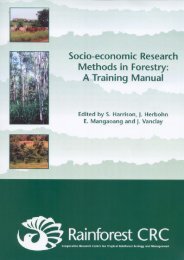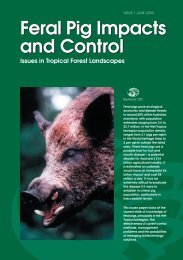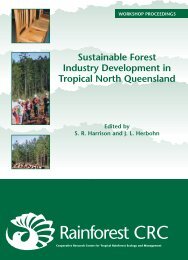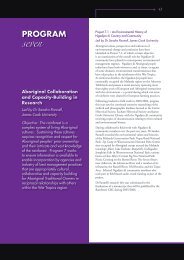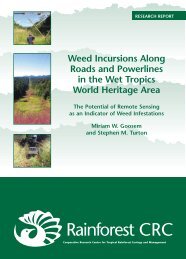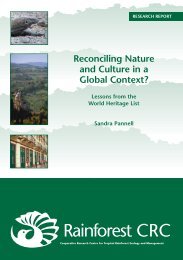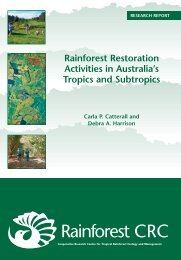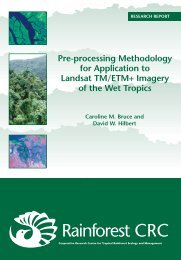Reconciling Nature and Culture in a Global Context? - Rainforest ...
Reconciling Nature and Culture in a Global Context? - Rainforest ...
Reconciling Nature and Culture in a Global Context? - Rainforest ...
You also want an ePaper? Increase the reach of your titles
YUMPU automatically turns print PDFs into web optimized ePapers that Google loves.
<strong>Reconcil<strong>in</strong>g</strong> <strong>Nature</strong> <strong>and</strong> <strong>Culture</strong> <strong>in</strong> a <strong>Global</strong> <strong>Context</strong>?Lessons from the World Heritage ListCHAPTER TWO – THE WET TROPICS WORLDHERITAGE AREA: A CONFUSION OF CATEGORIES?In 1988, after more than a decade of political wrangl<strong>in</strong>g between the Queensl<strong>and</strong> StateGovernment <strong>and</strong> the Australian Commonwealth Government, heated exchanges betweenconservationists <strong>and</strong> the pro-logg<strong>in</strong>g sector, <strong>and</strong> with varied Aborig<strong>in</strong>al opposition <strong>and</strong>support, the struggle to ‘secure’ (McDonald <strong>and</strong> Lane 2000) the wet tropical forests of NorthQueensl<strong>and</strong> culm<strong>in</strong>ated <strong>in</strong> their list<strong>in</strong>g as a World Heritage property at the Twelfth Session ofthe World Heritage Committee <strong>in</strong> Brasilia. This 894,420-hectare corridor of largelycontiguous ra<strong>in</strong>forest, extend<strong>in</strong>g along the eastern zone of the Great Divid<strong>in</strong>g Range fromCooktown to Townsville, was one of four properties nom<strong>in</strong>ated that year for their ‘outst<strong>and</strong><strong>in</strong>guniversal [natural] value’. By the end of 1988, a decade after the first twelve sites were<strong>in</strong>scribed on the World Heritage List (UNESCO 2005b), a total of 69 ‘natural’, 229 ‘cultural’<strong>and</strong> 14 ‘mixed’ properties had been listed.Among the ‘natural’ properties <strong>in</strong>scribed on the World Heritage List, the Wet Tropics is oftenheld up as unique <strong>in</strong> meet<strong>in</strong>g all four of the natural heritage criteria identified <strong>in</strong> theOperational Guidel<strong>in</strong>es for the Convention 6 as part of its assessment as a property with‘outst<strong>and</strong><strong>in</strong>g universal value’. As such, the region is listed for the follow<strong>in</strong>g values:criterion (i): “it conta<strong>in</strong>s one of the most complete <strong>and</strong> diverse liv<strong>in</strong>g records ofthe major stages <strong>in</strong> the evolution of l<strong>and</strong> plants […] as well as one of the mostimportant liv<strong>in</strong>g records of the history of marsupials <strong>and</strong> songbirds”;criterion (ii): it “provides outst<strong>and</strong><strong>in</strong>g examples of significant ongo<strong>in</strong>g ecologicalprocesses <strong>and</strong> biological evolution <strong>in</strong>clud<strong>in</strong>g exceptionally high levels ofspecies diversity <strong>and</strong> endemism reflect<strong>in</strong>g long-isolated ancient biota”;criterion (iii): it “has outst<strong>and</strong><strong>in</strong>g features of natural beauty <strong>and</strong> magnificentsweep<strong>in</strong>g l<strong>and</strong>scapes”; <strong>and</strong>criterion (iv): it “provides important habitats for the <strong>in</strong> situ conservation ofbiological diversity, <strong>in</strong>clud<strong>in</strong>g the only habitat for numerous species of plants<strong>and</strong> animals of conservation significance which have outst<strong>and</strong><strong>in</strong>g universalvalue from the po<strong>in</strong>t of view of science <strong>and</strong> conservation”(http://www.deh.gov.au/heritage/worldheritage/sites/wettropics/values.html).6 In 1988, the natural heritage criteria identified <strong>in</strong> the Operational Guidel<strong>in</strong>es for the Convention weredef<strong>in</strong>ed as:Criterion (i): outst<strong>and</strong><strong>in</strong>g examples represent<strong>in</strong>g the major stages of the earth’s evolutionary history;Criterion (ii): outst<strong>and</strong><strong>in</strong>g examples represent<strong>in</strong>g significant ongo<strong>in</strong>g geological processes, biologicalevolution <strong>and</strong> man’s <strong>in</strong>teraction with his natural environment […];Criterion (iii): conta<strong>in</strong> superlative natural phenomena, formations or features, for <strong>in</strong>stance,outst<strong>and</strong><strong>in</strong>g examples of the most important ecosystems, areas of exceptional natural beauty orexceptional comb<strong>in</strong>ations of natural <strong>and</strong> cultural elements; <strong>and</strong>Criterion (iv): conta<strong>in</strong> the most important <strong>and</strong> significant natural habitats where threatened species ofanimals or plants of outst<strong>and</strong><strong>in</strong>g universal value from the po<strong>in</strong>t of view of science or conservation stillsurvive (Operational Guidel<strong>in</strong>es 1988, http://whc.unesco.org/archive/opguide88.pdf).S<strong>in</strong>ce 1988, revision of the Operational Guidel<strong>in</strong>es has resulted <strong>in</strong> m<strong>in</strong>or changes to criterion (i), (ii)<strong>and</strong> (iii). For example, s<strong>in</strong>ce 1996, criterion (iii) [now criterion (vii)] has <strong>in</strong>cluded a reference to the‘aesthetic importance’ of a nom<strong>in</strong>ated property (World Heritage Committee 1996: 13).5




